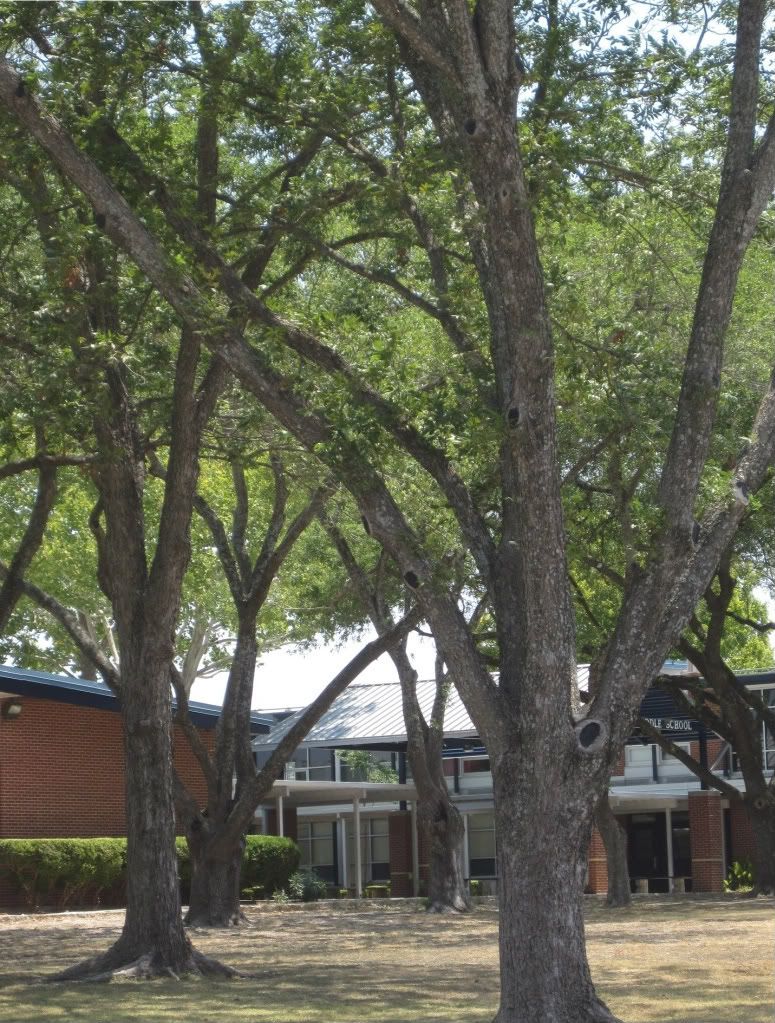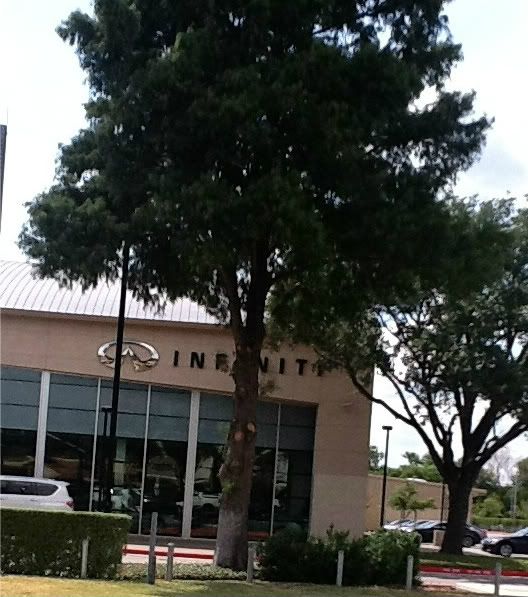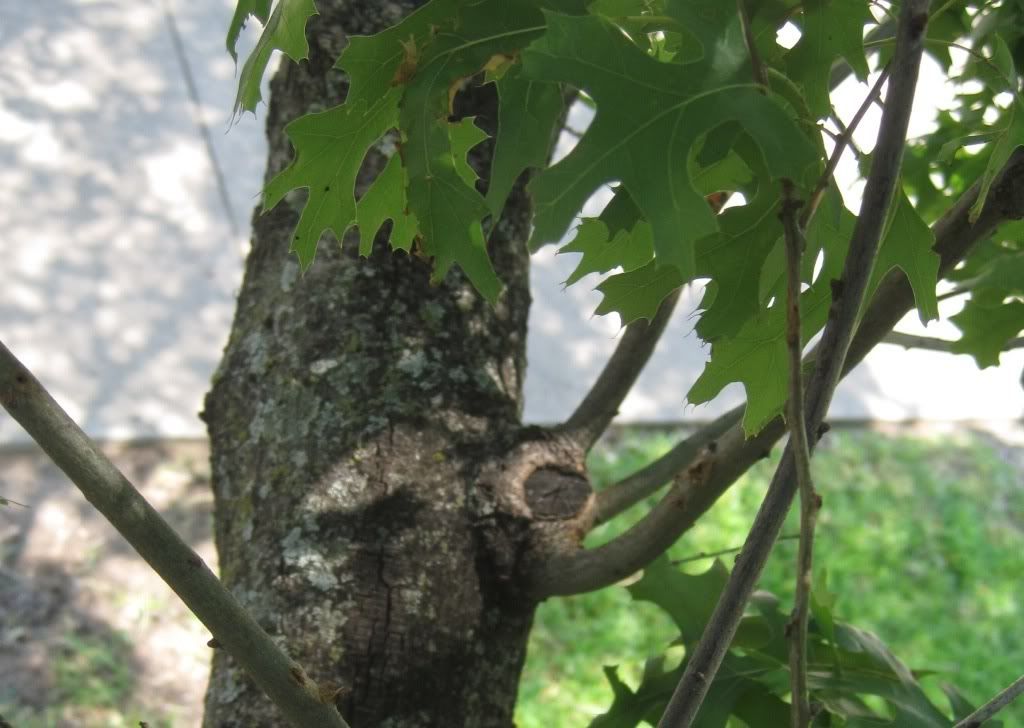 |
| People often ask to have the "suckers" removed from trees. |
The problem starts with the name itself. “Sucker” is a common term applied to the small interior sprouts that grow from the stem and major branches of a tree. Some people limit it to just the whips that grow up from the roots or base of the tree, but most of the time the gist is that there are a lot of dense, ugly little clusters of branches crowding up the middle. They want to see nice, “clean” branches arching gracefully to a nice spray of leaves at the ends.
 |
| Looks good to some, but weakens trees. |
There are many problems with this. First, there is no need to remove sprouts; these branches don't “suck” anything more from the tree than any other branch. Second, the more prolific the sprouts, the more likely it is that the tree truly needs them to shade itself and produce energy in response to some kind of damage. Third, the more we remove the interior branches from a tree, the more likely it is that the tree will suffer large branch failures in years to come. Fourth, in most cases, the more we strip out these interior branches, the more vigorously
the tree will try to replace them, making this an endless cycle.
 | ||
| Multiple wounds and potential for sun scald |
“Sucker” is just a poor way to describe the interior growth of a tree. Every new leaf a tree grows, regardless of its location, requires a small expenditure. However, as soon as the leaf gets started, it begins to produce energy for itself and the whole system. If there is any truth to this myth, it is this: to some degree, a tree has a finite amount of resources to fuel the photosynthetic reaction. If there are a lot of interior branches using some of these resources, there is less to be sent to the top of the tree, so it may take longer to reach its full height. Later, I will explain why this is actually a good thing, but it may help explain why this issue won't go away.
First, a little background: Tree branches grow in two ways. Each branch gets longer by adding new cells to its tip; this is called primary growth. After the first year, the branch continues to get longer but also increases in diameter by adding a new layer of wood just under the bark; this is called secondary growth. (It is secondary growth that creates the rings we count to learn the age of trees).
Every branch supports its parent. New branching occurs when a latent bud on the surface of a branch is stimulated by sunlight. In the upper canopy, this means the highest tips keep reaching higher, while the widest tips keep reaching wider, and the older parts of branches keep getting thicker.
So, imagine a large tree trunk, and a few feet up a really large branch comes off the side. The stem is thicker below that branch than above it, creating taper. So, a tree that has been excessively "elevated" all its life is roughly the same diameter where it originates as it has where the branching begins. A tree that has had more low branches retained may not be as tall, but it will be stouter and stronger.
Similarly, a branch in a full canopy has developed a distinct taper along its length, which makes it much stronger. This is why slowing a tree's vertical growth by diffusing its energy throughout many small branches can actually benefit the tree greatly over the long term.
Every branch supports its parent. New branching occurs when a latent bud on the surface of a branch is stimulated by sunlight. In the upper canopy, this means the highest tips keep reaching higher, while the widest tips keep reaching wider, and the older parts of branches keep getting thicker.
So, imagine a large tree trunk, and a few feet up a really large branch comes off the side. The stem is thicker below that branch than above it, creating taper. So, a tree that has been excessively "elevated" all its life is roughly the same diameter where it originates as it has where the branching begins. A tree that has had more low branches retained may not be as tall, but it will be stouter and stronger.
Similarly, a branch in a full canopy has developed a distinct taper along its length, which makes it much stronger. This is why slowing a tree's vertical growth by diffusing its energy throughout many small branches can actually benefit the tree greatly over the long term.
 |
| This Oak was sunburned badly. |
But, if a dramatic change occurs to suddenly put more light on the trunk (such as a storm break or removal of an adjacent tree), you get a quick flush of interior sprouts. Without the sprouts, the bark of the tree can be damaged by the sudden increase in sunlight, just as people sunburn. Sun scald can kill a section of bark, which is the tree's best defense against disease and insects. It might not even be very noticeable to the casual observer, but this damage can become a weak point where the branch will break someday. Further, since now all the active buds are at the tips, the branches get longer and longer without significant taper; this puts more strain over the length of the limb (the way a dumbbell tires us out more at arm's length than it does when held close to the body).
“Thinning” the canopy, a practice commonly promoted by some companies, isolates branches, which are ill-equipped to resist damage by themselves. A dense canopy parts the wind like a building, allowing branches to support each other. Add to that, a branch with all its weight at the end whips around more violently;
 |
| These "clean" trees are more likely to break in the wind. |
All of this is complicated by the fact that, in Austin, we have a lot of mature Live Oak trees. Live Oaks keep a dense canopy of leaves through the winter, so they tend to shade out their interior branches, developing an open crown naturally. So, homeowners look at their neighbors' oaks and want their trees look the same. Unfortunately, all trees are not equal. Ash trees especially will suffer the effects I have described above when routinely stripped out. Elms and Pecans, Hackberries, and most of our other large trees also tend to suffer more than Live Oaks as a result of this type of pruning. I can make your Ash tree look somewhat like a Live Oak, but I cannot make it nearly as strong as one.
 |
| Sprouts grow soon after drastic changes in sun. |
When faced with all these facts, it's a rare client that still insists on the strip-em-out annual program. Still, leaving interior sprouts is sometimes unattractive. I think it's okay to let the trees be ugly for awhile, but not everyone agrees.
For those who insist on improving the appearance of a particularly crowded tree, it is completely acceptable to thin out the sprouts to a few strong-looking, well spaced branches. In highly structured gardens, it might even be helpful to “clean” a short section of the largest limbs near each major branch union. The select few remaining branches, with any luck, will develop more quickly than the individual members of the cluster; they are likely to provide just as much shade as the whole group would have done.
By highlighting the tree's structure in this way, a talented arborist can keep the majority of the interior growth while distracting the eye from the shaggy sprouts that are helping the tree recover from a significant, stressful event (or events). A healthy tree will either develop some of the remaining sprouts into permanent branches, or higher branches will shade them out. Over time, the ugly clusters of sprouts will naturally fade away. Clients are happy and trees recover. Sprouts become a non-issue.
A well informed consumer will learn to look at the finished job differently; the best pruning work will focus on dead branches and specific problems (clearance issues, disease, natural damage, etc.). Rather than looking for a drastic change in the tree's appearance and a huge pile of green branches going into the chipper or trailer, they learn to expect mostly dead wood on the ground and a tree that looks a lot like it did before the pruning. There are exceptions, of course, but even a tree that needs to be reduced should look similar to when it started. Proper reductions occur in the dense, green tips where loss of branches is not as noticeable.
But some companies continue to promote the practice of removing “suckers,” while others will readily comply with a client's request to do so without informing them of the consequences. An uneducated consumer might end up with severely damaged trees despite the effort and expense of hiring a “professional.” And so, sadly, it turns out the real “suckers” are the people who get burned by these unethical and/or ignorant companies.
Protect your trees from unnecessary damage; whenever you interview potential arborists about the work on your trees, be sure to insist that interior live branches will not be removed unless absolutely necessary. If you have the time, ask for references and look at the company's previous work to make sure they understand what you are talking about. If more consumers do these things, the companies that prey on suckers might be forced to learn proper tree care.
